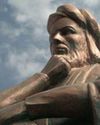
The history of computer science did not begin eighty years ago with the creation of the first electronic computer. To program a computer to process information – or in other words, to simulate thought we need to be able to understand, dismantle and disassemble thoughts. In IT-speak, in order to encrypt a thought, we must first be able to decrypt it! And this willingness to analyse thought already existed in ancient times. So the principles, laws, and concepts that underlie computer science today originated in an era when the principles of mathematics and logic each started on their own paths, around their respective iconic thinkers, such as Plato and Aristotle. Indeed, the history of computer science could be described as fulfilling the dream of bringing mathematics and logic together. This dream was highlighted for the first time during the thirteenth century by Raymond Lulle, a theologian and missionary from Majorca, but it became the dream of Gottfried Leibniz in particular. This German philosopher wondered why these two fields had evolved side by side separately since ancient times, when both seemed to strive for the same goal. Mathematicians and logicians both wish to establish undeniable truths by fighting against errors of reasoning and implementing precise laws of correct thinking. The Hungarian journalist, essayist and Nobel laureate Arthur Koestler called this shock (because it always is a shock) of an original pairing of two apparently very separate things a bisociation.
This story is from the {{IssueName}} edition of {{MagazineName}}.
Start your 7-day Magzter GOLD free trial to access thousands of curated premium stories, and 9,000+ magazines and newspapers.
Already a subscriber ? Sign In
This story is from the {{IssueName}} edition of {{MagazineName}}.
Start your 7-day Magzter GOLD free trial to access thousands of curated premium stories, and 9,000+ magazines and newspapers.
Already a subscriber? Sign In

Metaphors & Creativity
Ignacio Gonzalez-Martinez has a flash of inspiration about the role metaphors play in creative thought.

Medieval Islam & the Nature of God
Musa Mumtaz meditates on two maverick medieval Muslim metaphysicians.

Robert Stern
talks with AmirAli Maleki about philosophy in general, and Kant and Hegel in particular.

Volney (1757-1820)
John P. Irish travels the path of a revolutionary mind.

IT'S A WONDERFUL LIFE
Becky Lee Meadows considers questions of guilt, innocence, and despair in this classic Christmas movie.

"I refute it thus"
Raymond Tallis kicks immaterialism into touch.

Cave Girl Principles
Larry Chan takes us back to the dawn of thought.

A God of Limited Power
Philip Goff grasps hold of the problem of evil and comes up with a novel solution.

A Critique of Pure Atheism
Andrew Likoudis questions the basis of some popular atheist arguments.

Exploring Atheism
Amrit Pathak gives us a run-down of the foundations of modern atheism.